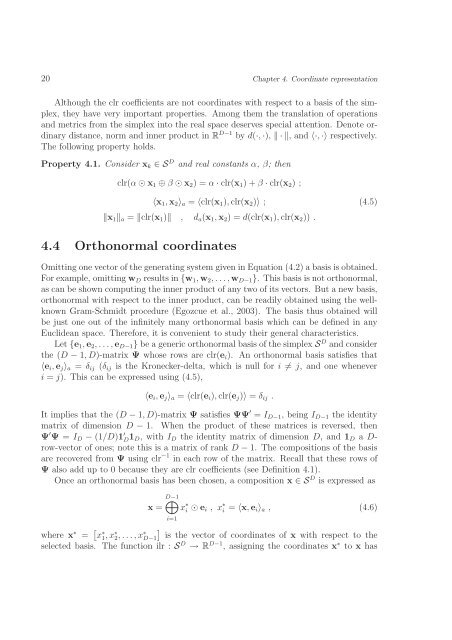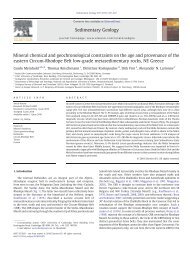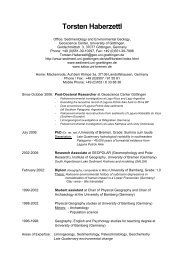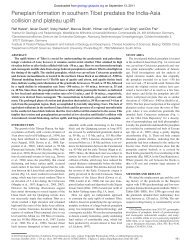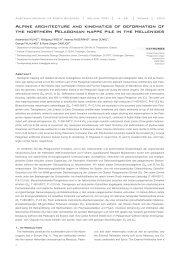Lecture Notes on Compositional Data Analysis - Sedimentology ...
Lecture Notes on Compositional Data Analysis - Sedimentology ...
Lecture Notes on Compositional Data Analysis - Sedimentology ...
Create successful ePaper yourself
Turn your PDF publications into a flip-book with our unique Google optimized e-Paper software.
20 Chapter 4. Coordinate representati<strong>on</strong><br />
Although the clr coefficients are not coordinates with respect to a basis of the simplex,<br />
they have very important properties. Am<strong>on</strong>g them the translati<strong>on</strong> of operati<strong>on</strong>s<br />
and metrics from the simplex into the real space deserves special attenti<strong>on</strong>. Denote ordinary<br />
distance, norm and inner product in R D−1 by d(·, ·), ‖ · ‖, and 〈·, ·〉 respectively.<br />
The following property holds.<br />
Property 4.1. C<strong>on</strong>sider x k ∈ S D and real c<strong>on</strong>stants α, β; then<br />
clr(α ⊙ x 1 ⊕ β ⊙ x 2 ) = α · clr(x 1 ) + β · clr(x 2 ) ;<br />
〈x 1 ,x 2 〉 a = 〈clr(x 1 ), clr(x 2 )〉 ; (4.5)<br />
‖x 1 ‖ a = ‖clr(x 1 )‖ , d a (x 1 ,x 2 ) = d(clr(x 1 ), clr(x 2 )) .<br />
4.4 Orth<strong>on</strong>ormal coordinates<br />
Omitting <strong>on</strong>e vector of the generating system given in Equati<strong>on</strong> (4.2) a basis is obtained.<br />
For example, omitting w D results in {w 1 ,w 2 , . . .,w D−1 }. This basis is not orth<strong>on</strong>ormal,<br />
as can be shown computing the inner product of any two of its vectors. But a new basis,<br />
orth<strong>on</strong>ormal with respect to the inner product, can be readily obtained using the wellknown<br />
Gram-Schmidt procedure (Egozcue et al., 2003). The basis thus obtained will<br />
be just <strong>on</strong>e out of the infinitely many orth<strong>on</strong>ormal basis which can be defined in any<br />
Euclidean space. Therefore, it is c<strong>on</strong>venient to study their general characteristics.<br />
Let {e 1 ,e 2 , . . .,e D−1 } be a generic orth<strong>on</strong>ormal basis of the simplex S D and c<strong>on</strong>sider<br />
the (D − 1, D)-matrix Ψ whose rows are clr(e i ). An orth<strong>on</strong>ormal basis satisfies that<br />
〈e i ,e j 〉 a = δ ij (δ ij is the Kr<strong>on</strong>ecker-delta, which is null for i ≠ j, and <strong>on</strong>e whenever<br />
i = j). This can be expressed using (4.5),<br />
〈e i ,e j 〉 a = 〈clr(e i ), clr(e j )〉 = δ ij .<br />
It implies that the (D − 1, D)-matrix Ψ satisfies ΨΨ ′ = I D−1 , being I D−1 the identity<br />
matrix of dimensi<strong>on</strong> D − 1. When the product of these matrices is reversed, then<br />
Ψ ′ Ψ = I D − (1/D)1 ′ D 1 D, with I D the identity matrix of dimensi<strong>on</strong> D, and 1 D a D-<br />
row-vector of <strong>on</strong>es; note this is a matrix of rank D − 1. The compositi<strong>on</strong>s of the basis<br />
are recovered from Ψ using clr −1 in each row of the matrix. Recall that these rows of<br />
Ψ also add up to 0 because they are clr coefficients (see Definiti<strong>on</strong> 4.1).<br />
Once an orth<strong>on</strong>ormal basis has been chosen, a compositi<strong>on</strong> x ∈ S D is expressed as<br />
D−1<br />
⊕<br />
x = x ∗ i ⊙ e i , x ∗ i = 〈x,e i 〉 a , (4.6)<br />
i=1<br />
where x ∗ = [ x ∗ 1, x ∗ 2, . . .,x ∗ D−1]<br />
is the vector of coordinates of x with respect to the<br />
selected basis. The functi<strong>on</strong> ilr : S D → R D−1 , assigning the coordinates x ∗ to x has


